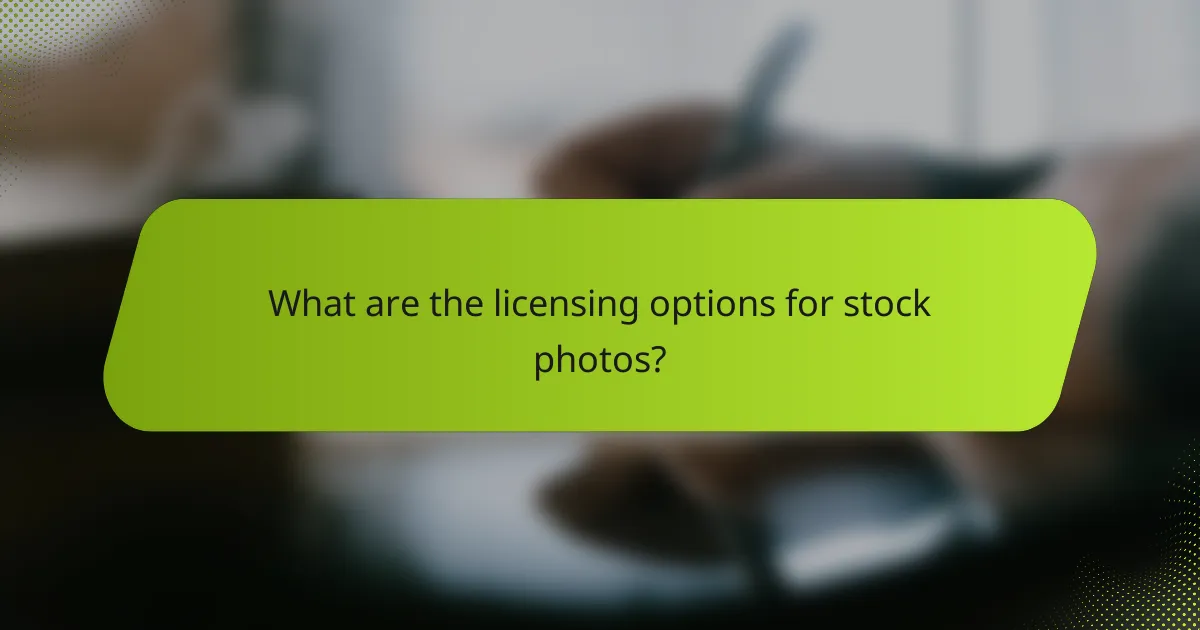Stock photos are essential resources for various projects, offering a wide range of quality images across multiple online platforms. Evaluating their quality involves considering factors like resolution, clarity, and composition, while understanding licensing options such as royalty-free and rights-managed is crucial for proper usage. Popular sites like Shutterstock, Adobe Stock, and Getty Images provide diverse collections to meet different needs and budgets.

Where to find quality stock photos in the US?
In the US, quality stock photos can be sourced from various online platforms that offer diverse collections and flexible licensing options. Popular sites include Shutterstock, Adobe Stock, and Getty Images, each catering to different needs and budgets.
Shutterstock
Shutterstock is one of the largest stock photo libraries, boasting millions of images across numerous categories. Users can purchase images through subscription plans or on-demand credits, making it accessible for both casual users and businesses.
When using Shutterstock, consider the licensing options available. Standard licenses cover most uses, but if you need images for merchandise or resale, an enhanced license may be necessary. Always check the specific terms to avoid potential legal issues.
Adobe Stock
Adobe Stock integrates seamlessly with Adobe Creative Cloud applications, making it a convenient choice for designers and creatives. It offers a vast collection of high-quality images, videos, and templates, available through subscription or credit packs.
Adobe Stock’s licensing is straightforward, with options for standard and extended licenses. The extended license allows for broader usage, including print runs over a certain threshold. Be sure to evaluate your project needs when selecting a license.
Getty Images
Getty Images is renowned for its premium quality and editorial content, making it ideal for professional use. It offers a wide range of images, including exclusive and historical content, but often at a higher price point compared to other platforms.
Licensing with Getty Images can be complex, as it varies significantly based on the image type and intended use. Always review the licensing agreements carefully to ensure compliance, especially for commercial projects.

How to evaluate the quality of stock photos?
Evaluating the quality of stock photos involves assessing their resolution, clarity, composition, and lighting. High-quality images should meet specific standards that enhance their usability for various projects.
Resolution and clarity
Resolution refers to the amount of detail an image holds, typically measured in pixels. For print purposes, aim for images with a resolution of at least 300 DPI (dots per inch), while digital use often requires 72 DPI or higher.
Clarity is equally important; images should be sharp and free of blurriness. When selecting stock photos, zoom in to check for pixelation or artifacts that may detract from the overall quality.
Composition and lighting
Composition involves the arrangement of elements within a photo, which can significantly impact its effectiveness. Look for images that follow the rule of thirds, leading lines, or other compositional techniques that draw the viewer’s eye.
Lighting plays a crucial role in the mood and clarity of a photo. Natural light often yields the best results, but ensure that shadows and highlights are balanced to avoid overexposure or underexposure. Consider how the lighting complements the subject matter for your intended use.

What are the licensing options for stock photos?
Stock photos typically come with two main licensing options: royalty-free and rights-managed. Understanding these options is crucial for selecting the right images for your projects while ensuring compliance with usage rights.
Royalty-free licenses
Royalty-free licenses allow users to pay a one-time fee to use the image multiple times without incurring additional costs. This type of license is popular for its flexibility, as it often permits a wide range of uses, including commercial applications.
When purchasing royalty-free images, check the specific terms, as some may have restrictions on distribution or usage in certain contexts. For instance, using an image in a product for resale may require a different license.
Rights-managed licenses
Rights-managed licenses are more restrictive and require users to pay based on specific usage parameters, such as duration, geographic distribution, and the type of project. This means that the cost can vary significantly depending on how you plan to use the image.
With rights-managed licenses, it’s essential to clearly define your intended use upfront. Failure to do so can lead to additional fees or legal issues if the image is used beyond the agreed terms. Always read the license agreement carefully to avoid common pitfalls.

What subject matters are popular in stock photography?
Popular subject matters in stock photography include business and technology themes, as well as nature and landscapes. These categories are frequently sought after by marketers, designers, and content creators for their versatility and broad appeal.
Business and technology
Business and technology images often depict corporate environments, teamwork, and modern devices. These visuals are essential for illustrating concepts like innovation, productivity, and digital transformation.
When selecting stock photos in this category, look for images that convey professionalism and clarity. High-quality visuals featuring diverse teams and up-to-date technology tend to resonate well with audiences.
Common pitfalls include using outdated or overly generic images. Aim for authenticity by choosing photos that reflect real-life scenarios relevant to your target audience.
Nature and landscapes
Nature and landscape photography captures the beauty of the natural world, including mountains, forests, and oceans. These images are ideal for projects focused on environmental themes, travel, and wellness.
To effectively use stock photos in this category, consider the mood and message you want to convey. Bright, vibrant images can evoke feelings of joy and adventure, while muted tones may suggest tranquility and reflection.
Be cautious of overused clichés, such as generic sunset images. Instead, seek unique perspectives or lesser-known locations to create a more engaging visual narrative.

How to choose the right stock photo for your project?
Choosing the right stock photo involves understanding your project’s needs and the audience’s expectations. Consider factors such as subject matter, licensing, and the emotional tone you want to convey.
Consider your audience
Your audience’s demographics and preferences significantly influence the type of stock photo you should select. For instance, images aimed at a younger audience might feature vibrant colors and modern themes, while those for a corporate setting may require more subdued tones and professional imagery.
Researching your target audience can help you identify the styles and subjects that resonate best. Utilize analytics tools or surveys to gather insights on what visual elements appeal to your specific group.
Match the theme and tone
The theme and tone of your project should align with the stock photo you choose. For example, if your project is about wellness, opt for images that evoke calmness and positivity, such as serene landscapes or people engaging in healthy activities.
Pay attention to the colors, composition, and subjects in the photos. A cohesive visual style enhances your message and maintains consistency across your materials. Avoid images that clash with your brand identity or the overall mood of your project.

What are the pricing models for stock photos?
Stock photos are typically priced through subscription plans or pay-per-image options. Each model has its advantages, depending on the frequency of use and specific needs of the buyer.
Subscription plans
Subscription plans allow users to pay a recurring fee for access to a library of stock images. These plans often come in various tiers, offering different numbers of downloads per month, which can range from a few images to hundreds.
For frequent users, subscription models can be cost-effective, as they usually lower the per-image cost. However, it’s essential to assess your usage to avoid paying for unused downloads.
Pay-per-image options
Pay-per-image options charge users a fee for each individual stock photo downloaded. This model is ideal for those who need images infrequently or for specific projects, as it avoids the commitment of a subscription.
Prices for pay-per-image can vary widely based on the quality and exclusivity of the image, typically ranging from a few dollars to several hundred. Be cautious of additional licensing fees that may apply for commercial use.

What are the trends in stock photography?
Current trends in stock photography emphasize authenticity, diversity, and the integration of AI-generated images. These trends reflect the evolving preferences of consumers and the need for more relatable and unique visual content.
Authenticity and diversity
Authenticity and diversity in stock photography are increasingly important as consumers seek images that reflect real-life experiences and varied backgrounds. Stock photos now often feature models of different ethnicities, ages, and body types to resonate with a broader audience.
To effectively capture authenticity, photographers should focus on candid moments and genuine expressions rather than staged poses. This approach can enhance relatability and engagement with viewers, making the images more appealing for marketing and branding purposes.
Use of AI-generated images
The use of AI-generated images is becoming a significant trend in stock photography, offering unique visuals that can be tailored to specific needs. These images can be created quickly and at a lower cost compared to traditional photography, making them an attractive option for businesses.
However, while AI-generated images can provide variety, it’s essential to ensure they align with brand identity and messaging. Users should also be aware of licensing issues, as the legal landscape surrounding AI-generated content is still developing. Always check the usage rights before incorporating these images into projects.

How to ensure compliance with stock photo licensing?
Ensuring compliance with stock photo licensing involves understanding the terms of use associated with each image. Always read the licensing agreements carefully to avoid legal issues and ensure proper usage.
Understanding different types of licenses
Stock photos typically come with various licensing options, including royalty-free and rights-managed licenses. Royalty-free licenses allow for broader use without ongoing fees, while rights-managed licenses restrict usage based on specific terms, such as duration and geography.
When selecting images, consider how you plan to use them. For instance, if you need an image for a one-time marketing campaign, a rights-managed license may be appropriate. Conversely, if you require flexibility for multiple projects, a royalty-free license is likely a better choice.
Key licensing terms to know
Familiarize yourself with essential licensing terms such as “commercial use,” “editorial use,” and “attribution.” Commercial use typically refers to images used for promotional purposes, while editorial use is limited to non-commercial contexts, like news articles.
Attribution may be required for certain licenses, meaning you must credit the creator when using their work. Be sure to check if the license specifies how to provide this credit, as it can vary by provider.
Common pitfalls to avoid
One common pitfall is assuming that all stock photos are free to use without restrictions. Always verify the licensing terms before downloading or using an image. Misunderstanding the scope of a license can lead to costly legal disputes.
Another mistake is neglecting to keep records of your licenses. Maintain documentation of your purchases and the specific terms associated with each image to protect yourself in case of disputes.

